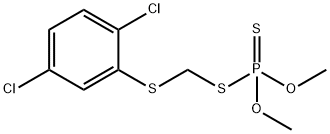|
|
| | METHYL PHENCAPTON Basic information |
| Product Name: | METHYL PHENCAPTON | | Synonyms: | METHYL PHENCAPTON;Phosphorodithioic acid, S-[[(2,5-dichlorophenyl)thio]methyl] O,O-dimethyl ester | | CAS: | 3735-23-7 | | MF: | C9H11Cl2O2PS3 | | MW: | 349.26 | | EINECS: | | | Product Categories: | | | Mol File: | 3735-23-7.mol |  |
| | METHYL PHENCAPTON Chemical Properties |
| RIDADR | 3018 | | HazardClass | 6.1(b) | | PackingGroup | III |
| | METHYL PHENCAPTON Usage And Synthesis |
| Description | Methyl phenkapton is a liquid product.Molecular weight = 349.25. Hazard Identification (based onNFPA-704 M Rating System): Health 3, Flammability 1,Reactivity 0. | | General Description | Liquid. Used as an acaricide, insecticide. Not registered as a pesticide in the U.S. | | Reactivity Profile | Organophosphates, such as METHYL PHENCAPTON, are susceptible to formation of highly toxic and flammable phosphine gas in the presence of strong reducing agents such as hydrides. Partial oxidation by oxidizing agents may result in the release of toxic phosphorus oxides. | | Health Hazard | (Non-Specific -- Organic Phosphorus Insecticides) Organic phosphorus insecticides are absorbed by the skin, as well as by the respiratory and gastrointestinal tracts. Toxic hazard rating (oral) is high. | | Fire Hazard | (Non-Specific -- Organophosphorus Pesticide, n.o.s.) Cylinder may explode in heat of fire. Heat may cause decomposition and evolution of highly toxic fumes of phosphorus oxides and chlorides. | | Potential Exposure | This material is an acaricide, insecticide. Not registered as a pesticide in the United States. | | First aid | If this chemical gets into the eyes, remove anycontact lenses at once and irrigate immediately for at least15 min, occasionally lifting upper and lower lids. Seek medical attention immediately. If this chemical contacts theskin, remove contaminated clothing and wash immediatelywith soap and water. Speed in removing material from skinis of extreme importance. Shampoo hair promptly if contaminated. Seek medical attention immediately. If thischemical has been inhaled, remove from exposure, beginrescue breathing (using universal precautions, includingresuscitation mask) if breathing has stopped and CPR ifheart action has stopped. Transfer promptly to a medicalfacility. When this chemical has been swallowed, get medical attention. Give large quantities of water and inducevomiting. Do not make an unconscious person vomit.Effects of exposure may be delayed. Medical monitoring isadvised. | | storage | Color Code—Blue: Health Hazard/Poison: Storein a secure poison location. Prior to working with thischemical you should be trained on its proper handling andstorage. Store in tightly closed containers in a cool, wellventilated area away from oxidizers and reducing agents.Where possible, automatically pump liquid from drums orother storage containers to process containers. | | Shipping | Organophosphorus pesticides, liquid, toxic,require a shipping label of “POISONOUS/TOXICMATERIALS.” It falls in Hazard Class 6.1 and PackingGroup III. | | Incompatibilities | Strong oxidizers may cause release oftoxic phosphorus oxides. Organophosphates, in the presenceof strong reducing agents such as hydrides, may formhighly toxic and flammable phosphine gas. | | Short Term Exposure | Organic phosphorus insecticidesare absorbed by the skin, as well as by the respiratory andgastrointestinal tracts. They are cholinesterase inhibitors.Symptoms of exposure include headache, giddiness, blurredvision, nervousness, weakness, nausea, cramps, diarrhea,and discomfort in the chest. Signs include sweating, tearing,salivation, vomiting, cyanosis, convulsions, coma, loss ofreflexes, and loss of sphincter control. | | Long Term Exposure | Cholinesterase inhibitor; cumulativeeffect is possible. This chemical may damage the nervoussystem with repeated exposure, resulting in convulsions,respiratory failure. May cause liver damage. | | Personal Protective Methods | Wear protective gloves andclothing to prevent any reasonable probability of skin contact. Safety equipment suppliers/manufacturers can providerecommendations on the most protective glove/clothingmaterial for your operation. All protective clothing (suits,gloves, footwear, headgear) should be clean, available eachday, and put on before work. Contact lenses should not beworn when working with this chemical. Wear splash-proofchemical goggles and face shield unless full face-piecerespiratory protection is worn. Employees should washimmediately with soap when skin is wet or contaminated.Provide emergency showers and eyewash. | | Fire Extinguishing | This material may burn but does notignite readily. Poisonous gases, including sulfur oxide,phosphorus oxide, and chlorine, are produced in fire. Forsmall fires, use dry chemical, carbon dioxide, water spray,or foam. For large fires, use water spray, fog, or foam. Stayupwind; keep out of low areas. Move containers from firearea if you can do it without risk. Fight fire from maximumdistance. Dike fire control water for later disposal; do notscatter the material. Wear positive pressure breathing apparatus and special protective clothing. Containers mayexplode in fire. Storage containers and parts of containersmay rocket great distances, in many directions. If materialor contaminated runoff enters waterways, notify downstream users of potentially contaminated waters. Notifylocal health and fire officials and pollution control agencies.From a secure, explosion-proof location, use water spray tocool exposed containers. If cooling streams are ineffective(venting sound increases in volume and pitch, tank discolors, or shows any signs of deforming), withdraw immediately to a secure position. If employees are expected tofight fires, they must be trained and equipped in OSHA1910.156. The only respirators recommended for firefighting are self-contained breathing apparatuses that have fullface-pieces and are operated in a pressure-demand or otherpositive-pressure mode. | | Disposal Method Suggested | In accordance with 40CFR165 recommendations for the disposal of pesticides and pesticide containers. Must be disposed properly by followingpackage label directions or by contacting your local or federal environmental control agency or by contacting yourregional EPA office. |
| | METHYL PHENCAPTON Preparation Products And Raw materials |
|